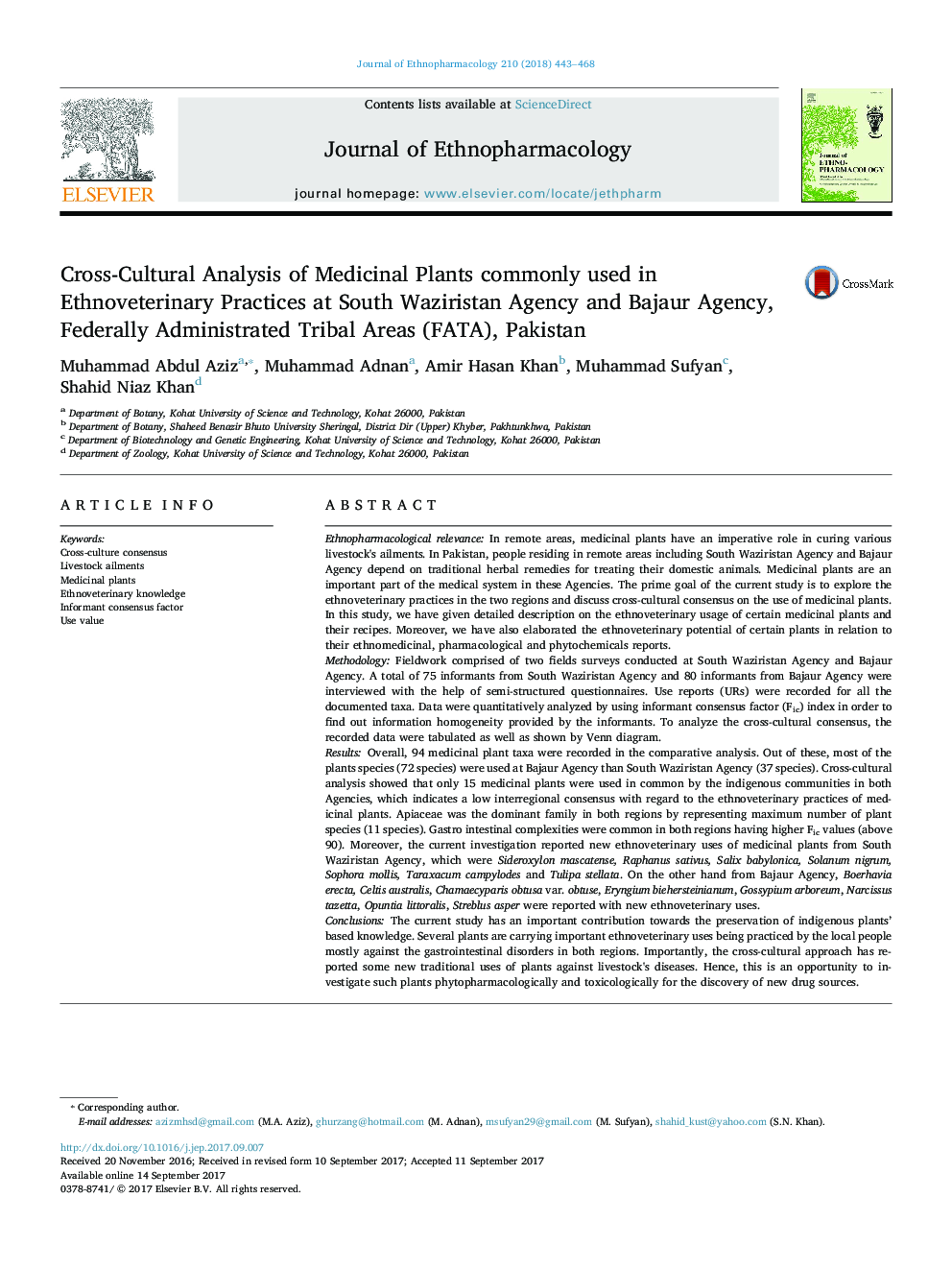| کد مقاله | کد نشریه | سال انتشار | مقاله انگلیسی | نسخه تمام متن |
|---|---|---|---|---|
| 5555956 | 1560352 | 2018 | 26 صفحه PDF | دانلود رایگان |

Ethnopharmacological relevanceIn remote areas, medicinal plants have an imperative role in curing various livestock's ailments. In Pakistan, people residing in remote areas including South Waziristan Agency and Bajaur Agency depend on traditional herbal remedies for treating their domestic animals. Medicinal plants are an important part of the medical system in these Agencies. The prime goal of the current study is to explore the ethnoveterinary practices in the two regions and discuss cross-cultural consensus on the use of medicinal plants. In this study, we have given detailed description on the ethnoveterinary usage of certain medicinal plants and their recipes. Moreover, we have also elaborated the ethnoveterinary potential of certain plants in relation to their ethnomedicinal, pharmacological and phytochemicals reports.MethodologyFieldwork comprised of two fields surveys conducted at South Waziristan Agency and Bajaur Agency. A total of 75 informants from South Waziristan Agency and 80 informants from Bajaur Agency were interviewed with the help of semi-structured questionnaires. Use reports (URs) were recorded for all the documented taxa. Data were quantitatively analyzed by using informant consensus factor (Fic) index in order to find out information homogeneity provided by the informants. To analyze the cross-cultural consensus, the recorded data were tabulated as well as shown by Venn diagram.ResultsOverall, 94 medicinal plant taxa were recorded in the comparative analysis. Out of these, most of the plants species (72 species) were used at Bajaur Agency than South Waziristan Agency (37 species). Cross-cultural analysis showed that only 15 medicinal plants were used in common by the indigenous communities in both Agencies, which indicates a low interregional consensus with regard to the ethnoveterinary practices of medicinal plants. Apiaceae was the dominant family in both regions by representing maximum number of plant species (11 species). Gastro intestinal complexities were common in both regions having higher Fic values (above 90). Moreover, the current investigation reported new ethnoveterinary uses of medicinal plants from South Waziristan Agency, which were Sideroxylon mascatense, Raphanus sativus, Salix babylonica, Solanum nigrum, Sophora mollis, Taraxacum campylodes and Tulipa stellata. On the other hand from Bajaur Agency, Boerhavia erecta, Celtis australis, Chamaecyparis obtusa var. obtuse, Eryngium biehersteinianum, Gossypium arboreum, Narcissus tazetta, Opuntia littoralis, Streblus asper were reported with new ethnoveterinary uses.ConclusionsThe current study has an important contribution towards the preservation of indigenous plants' based knowledge. Several plants are carrying important ethnoveterinary uses being practiced by the local people mostly against the gastrointestinal disorders in both regions. Importantly, the cross-cultural approach has reported some new traditional uses of plants against livestock's diseases. Hence, this is an opportunity to investigate such plants phytopharmacologically and toxicologically for the discovery of new drug sources.
Comparative analysis of Veterinary practices at South Waziristan Agency and Bajaur Agency.239
Journal: Journal of Ethnopharmacology - Volume 210, 10 January 2018, Pages 443-468